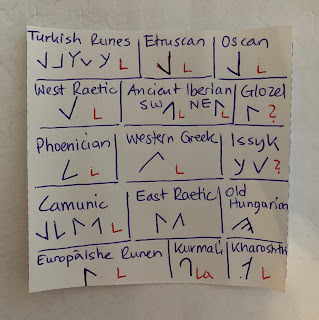Hello again,
it goes on, yes, I like to do it.
Now you see the runes and the signs and the letters that have the sound value D/T.
The Scotch St Andrew cross-like X rune of the Turks you can see by European Runes, Phoenician, Ancient Iberians, Kurmali.
The + you see by Kharoschthi, Glozel (value undefined) Ancient Iberian.
Linear A and Linear B have similar signs, too.
And now the runes/letters that have the sound value B.
Ancient Iberian NE Rune ist the same like Turkish Rune, even their sound value is the same EB.
EB means in Turkish House and this rune has the shape of a house.
Ancient Iberian SW sign is the upside-down form of Turkish round B, and they both look like Phoenician sign but this one has edges.
Kharoschthi looks like the Turkish 3rd B Rune on this paper.
And thirdly today the signs with the value C/Ç (C like J-ungle, Ç like Ch-air)
The first Turkish Rune -UC- is a stylized form of a peak. Uc means peak or the head of something.
The 2nd rune -UÇ- is a stylized form of a bird that can fly. Fly means in Turkish uç-.
In Issyk Kurgan and on Glozel founds we find the both, but we are not sure about their sound values.
Old Hungarian and Elder Futhark have the same rune with the sound value Z.
Kharoschthi has similar signs with sound value CHHA and CHA.
Iberians have not the same but very similar signs, too, especially NE one.
Kurmali has similar signs with JHA, CHA and CHHA sound values.
Linear A hav very similar signs to Turkish and Iberian ones, sound valuer are undefined.
And the most boring one.
L
Almost all the signs are same. Etruscan and other Italian signs are more like Turkish runes than the Phoenician one. None of them has the same direction like the Phoenician one => L
Issyk has the same runes like the Turkish ones. Their sound value is undefined.
Indian Systems Kurmali and Khoraschthi have similar ones Kurmali is round.
Old Hungarian is more handsome.
And here is a fun fact. EL means hand in Turkish and the Turkish Runes of L look like hands.
On this Paper you see a very funny idea of somebody I don't know anymore. But a nice idea anyway.
And a very interesting one.
M
the Fish or the zigzag or the X
The Turkish has a fish with a x and Proto Bulgarian Linear A and B have fishes, too.
Iberians have Phoenician zigzags and Linear A has them, too.
The last Turkish Rune is very similar to next Linear A sign, what do you mean?
European Runes are X's with fences.
An Ibex on Bilge Kagan's memorial Stone - Orhun Abideleri - Orhun Runes
And now my paper:
Sound value K-Q
Look at the first line
Indian Kurmali, Futhark and Old Bulgarian have the same sign for the same sound value. But how is it possible?
The Turkish delta we can see on Glozel founds and in Old Hungarian script.
Turkish 'h' form or Ibex form K we can find by European Runes and Kharoschthi signs with sound value K.
Turkish arrow like K we find by Etruscan (sound value kh) and Turkish 'B' like Rune by Linear A with the sound value ku.
Linear a has further an arrow and an ibex but sound values are undefined.
And now let your fantasy live.
The Ibex (Türkisch a very divine animal) gave its form to 2 Runes.
Ök means divine and this animal, too, because it was the closest animal ti Tengri (Turkish God).
That's why Bilge Kagan has it on his memorial stone. Hungarian Tör-ök means Turkish.
That's all folks.
Have a nice day.
Uzunbacak Adem














No comments:
Post a Comment
Note: Only a member of this blog may post a comment.